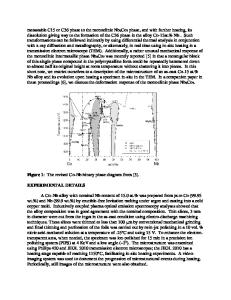Dehydrogenation and Sintering of TiH 2 : An In Situ Study
- PDF / 3,185,085 Bytes
- 11 Pages / 593.972 x 792 pts Page_size
- 9 Downloads / 386 Views
UCTION
DUE to low density, excellent corrosion resistance, and good mechanical properties, titanium and its alloys have been attracting attention in multiple fields.[1–3] The widely used powder metallurgy (P/M) methods offer near-net-shaping manufacturing of titanium products, exhibiting effectiveness and low-cost merits.[1] Titanium hydride (TiH2) powders are frequently involved in P/M to produce titanium products with satisfactory performance as compared with the products made from Ti powders.[4–7] It is speculated that the use of TiH2 powder lowers final oxygen content, and potentially promotes chemical homogenization and densification in the final sintered titanium products, because of its dehydrogenation effect during sintering.[4,8–10] The promoting effect on densification in titanium materials has been reported in pure Ti, Ti-6Al-4V, Ti-5Al-2.5Fe, and TiAl.[4,11,12] Furthermore, it has been revealed by in situ high-energy X-ray diffraction (XRD) studies that hydrogen plays a
GANG CHEN is with the Department of Chemical and Materials Engineering, The University of Auckland, Private Bag 92019, Auckland 1142, New Zealand, also with the State Key Laboratory of Porous Metal Materials, Northwest Institute for Nonferrous Metal Research, Xi’an, 710016, Shaanxi, People’s Republic of China, and also with the State Key Laboratory for Powder Metallurgy, Central South University, Changsha, 410083, Hunan, People’s Republic of China. KLAUS D. LISS is with the Australian Nuclear Science and Technology Organisation (ANSTO), New Illawarra Road, Lucas Heights, NSW, 2234, Australia. GRAEME AUCHTERLONIE is with the Centre for Microscopy and Microanalysis, The University of Queensland, St. Lucia, QLD, 4072, Australia. HUIPING TANG is with the State Key Laboratory of Porous Metal Materials, Northwest Institute for Nonferrous Metal Research. PENG CAO is with the Department of Chemical and Materials Engineering, The University of Auckland. Contact e-mail: [email protected] Manuscript submitted August 24, 2016. METALLURGICAL AND MATERIALS TRANSACTIONS A
particular role in the reaction kinetics in the TiH2/Ti/Al powder mixtures that were consolidated by equal channel angular pressing.[13] However, these sintering studies[4,11–13] only compared the sintered parts using Ti and TiH2 in their final forms after sintering. An entire picture of how the dehydrogenation and sintering proceed is lacking. In addition, the reported densification-enhancing effect by dehydrogenation may not apply to other titanium alloys. For example, our recent work reveals that less densification was observed in Ni/ TiH2 compacts, as compared to Ni/Ti compacts.[7,8,14,15] We hypothesized that the inter-particle space (porosity) increased by TiH2 dehydrogenation, while Ni particles did not react with the dehydrogenated Ti at the initial sintering stage; this lowered densification in the final sintered state. From a technical point of view, a better understanding of the role of early-stage dehydrogenation and its influence on microstructural development is important for achievi
Data Loading...











